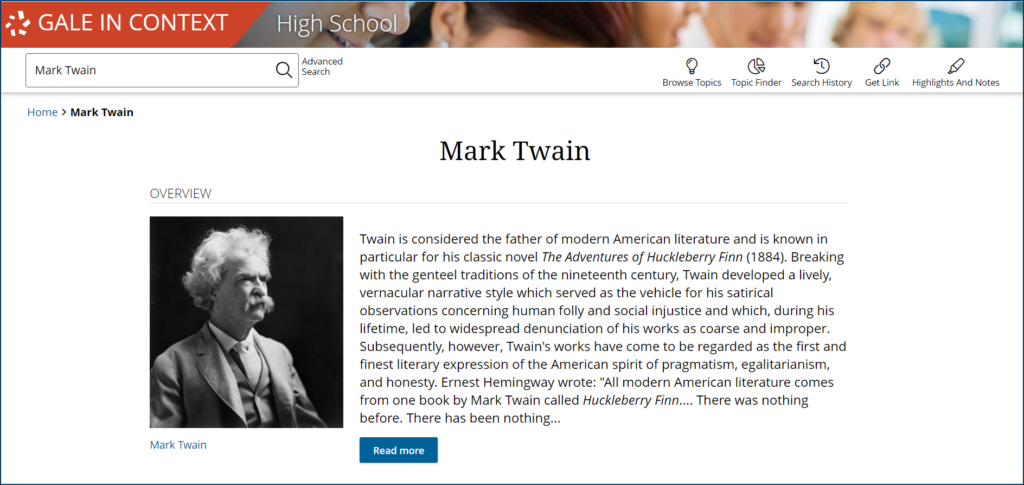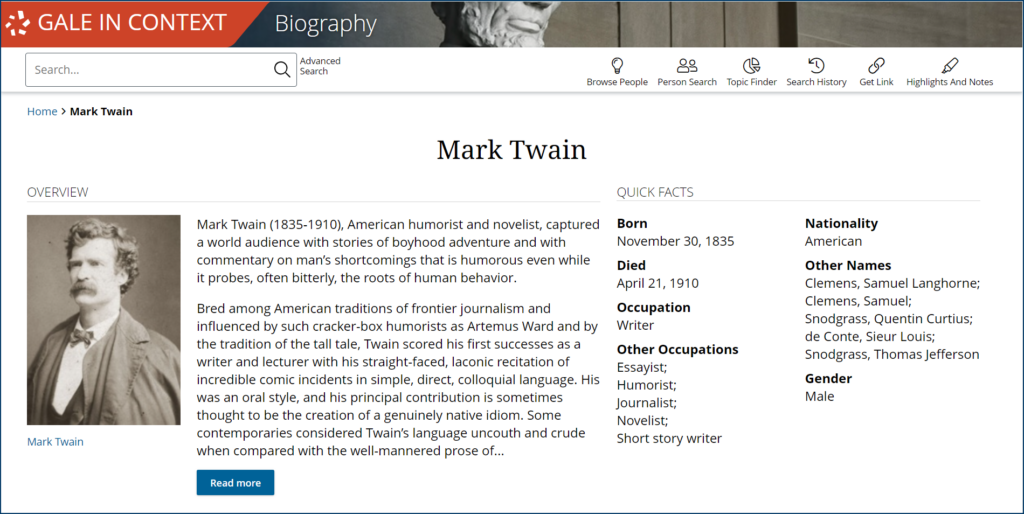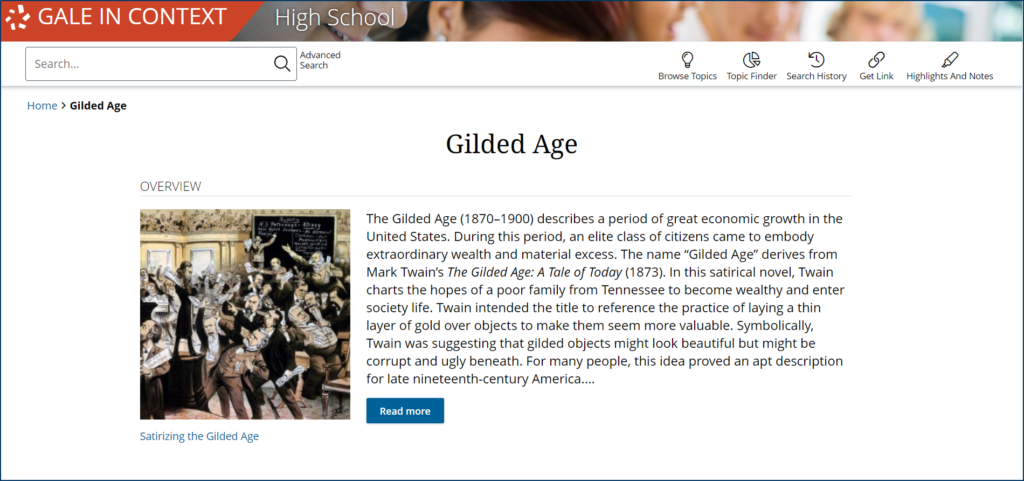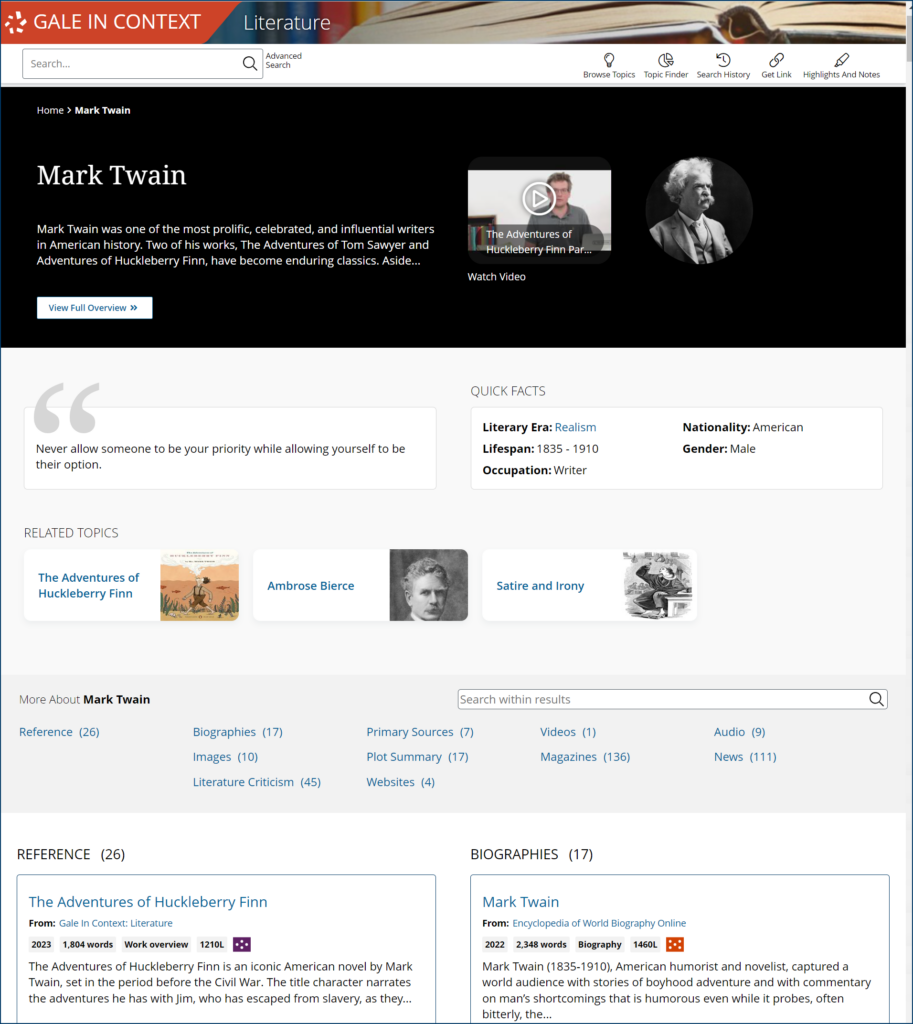| By Gale Staff |
Mark Twain is a pinnacle figure in American literature. He was a novelist and travel writer best known for The Adventures of Tom Sawyer and The Adventures of Huckleberry Finn. His social commentaries defined the early American experience, and his literary legacy endures through generations of readers.
While most people are familiar with Twain’s major titles, your students might be less aware of the author himself. What inspired Twain’s writing? How did his satirical stories become so deeply ingrained in American culture? For example, The Adventures of Huckleberry Finn was once required reading in over 70% of U.S. high schools.
In honor of his birthday on November 30, bring Twain to life with assistance from Gale’s high school databases. Gale In Context features user-friendly search functionality, consistent formatting, and specialized resources for your lesson plans. These valuable collections boast compelling content on Twain’s accomplishments as a writer, adventurous life stories, and long-standing influence on American literature.
Get to Know the Prolific Author
Mark Twain’s work is extensive; throughout his lifetime, he published more than 20 books and thousands of articles. Introduce Twain using the topic page on Gale In Context: High School. These accessible and curriculum-aligned summary pages offer key information and provide embedded critical-thinking questions to guide students and stimulate classroom discussion.
Born Samuel Langhorne Clemons, Twain had a playful, albeit impoverished, childhood—one whose adventures would later inform his beloved fictional characters. Growing up alongside the Mississippi River, Twain spent his days fishing, playing pirates, and swimming. Notably, he was fascinated by the lives of the passing riverboat workers, as the steamboats were a daily occurrence. In fact, at age 21, despite his blossoming writing career, Twain pursued his dream and apprenticed on a riverboat for two years.
Although he never completed his formal education, Twain possessed a natural talent for written humor. As a teenager, he worked alongside his older brother, who owned the local Western Union newspaper. By 17, his first comedic sketch, “The Dandy Frightening the Squatter,” was published, and his success ballooned from there. Twain would spend his early 20s working in printshops throughout the United States, from Washington D.C. to St. Louis to Cincinnati. He used a lively, pragmatic narrative style to design poignant commentaries on the period’s social and economic injustices.
Unsurprisingly, his sometimes scathing editorials led to the occasional confrontation—Twain even claimed to have been challenged to a duel by the editor of a rival newspaper. His critical and often controversial perspective inspired the need for a pen name, allowing him much-desired literary freedom. Hence, Mark Twain was born. However, despite using a pseudonym, Twain never backed down from his detractors.
Discussion Idea: Clemons adopted the pen name Mark Twain as a nod to his early fascination with riverboats. The term “Mark Twain” described a crewman’s expression for a water depth of roughly 12 feet; calling out “Mark Twain” signifies the water is safe for a steamship to navigate. Have students consider reasons an author might write under a pseudonym. You might even encourage students to brainstorm their own pen names, fostering a deeper understanding of the author and his creative process.
Explore a Timeline of Twain’s Fascinating Life
Twain’s life was full of exciting adventures. He briefly enlisted at the start of the Civil War, but soon resigned and moved out west instead. Throughout his 30s, his work as a reporter would lead him from California and Hawaii all the way to Nicaragua and Europe. He became a father, an inventor, and an Ivy League graduate. There was no challenge too daunting for Mark Twain.
Use Gale In Context: Biography to create a timeline to illustrate his impressive life and highlight its significant events. Gale In Context: Biography has thousands of thoughtfully crafted biography topic pages on a range of contemporary and historical figures, guiding your students on a research adventure of their own.
1835: Samuel Clemons is born prematurely in the village of Florida, Missouri. He is the sixth of seven children in the family, and because of his fragile health at birth, he isn’t expected to live.
1839: The family moves to the nearby town of Hannibal, along the banks of the Mississippi River. While Twain’s father dabbles in various businesses, family finances are shaky at best. Throughout his childhood, Twain is a passionate reader and close to his siblings. Twain spends his days gallivanting with a rowdy group of friends and watching the daily activities on the busy river.
1847: Twain is just 12 years old when his father dies. He leaves school to begin apprenticing with a local printer.
1852: Twain’s short story, “The Dandy Frightening the Squatter,” is published in a Boston newspaper called The Carpet-Bag. Soon after, he travels around the U.S., writing for local newspapers.
1859: He becomes a licensed riverboat pilot, fulfilling his long-held childhood fascination with life on the Mississippi. He would work as a steamboat pilot until the Civil War broke out in 1861.
1861: He follows his brother to Nevada and works briefly as a miner. However, he quickly returns to life as a reporter, writing humorous articles about local politics, gossip, and mining incidents for the Territorial Enterprise. During this period, he adopts the pen name Mark Twain.
1865: Twain’s short story, originally titled “Jim Smiley and His Jumping Frog,” is published in The New York Saturday Press. The story was later retitled as “The Celebrated Jumping Frog of Calaveras County.”
1866: Working as a news correspondent for the Sacramento Union, Twain travels to Hawaii. He captivates readers with his exotic tales, including details like the customs of a Hawaiian royal funeral and the sound of lava at the summit of Kīlauea.
1867: Twain boards a steamship and travels to Europe and the Middle East. The trip would inspire his first novel, The Innocents Abroad.
1870: Despite his working-class background, Twain courts and marries the wealthy Olivia Langdon. Their first child, a son, dies in infancy, but the couple would go on to have three daughters.
1876: The Adventures of Tom Sawyer is published. The novel is not an immediate success, as some critics feel the story is too short or too vulgar.
1885: The Adventures of Huckleberry Finn is published and popular among readers. However, as with Tom Sawyer, Twain receives criticism about the book’s “vulgarity.”
1894: Despite his literary success and book tours, Twain, like his father before him, mismanages his money and files for bankruptcy.
Up until his death in 1910, Twain continued to travel and tour as an author. He was a notable figure throughout the country’s Gilded Age and made connections with many famous contemporaries, including Rudyard Kipling, Frederick Douglass, and Harriet Beecher Stowe.
Discussion Idea: While researching his biography, encourage students to identify ways they relate to the enigmatic author. He experienced mixed success during his lifetime and likely had more critics than fans. So, what kind of person was Mark Twain, and what can be learned from his life story?
Consider How Twain’s Life Informed His Work
After learning the details of his life, it’s easy to see the parallels between Twain’s personal experience and his novels. Huck’s escape along the Mississippi River (inspired by Twain’s time on the riverboat) or Tom Sawyer’s crush on Becky Thatcher (based on Twain’s real-life pursuit of Laura Hawkins) are easy examples.
With Gale In Context: Literature, you can get a broader sense of how Mark Twain’s life influenced his work without having to read his complete anthology. Hundreds of pages provide students with essential overviews of his major literary works alongside contextual information like primary sources or literary criticisms.
The Mark Twain portal offers synopses of his most famous novels. Begin with The Adventures of Huckleberry Finn, a book that Ernest Hemingway once described as the root of all American literature. Set in the pre-Civil War South, the novel follows the perspective of Huck, a mischievous, albeit well-meaning, teenager living with an abusive father. To escape his home life, Huck fakes his own death and befriends a runaway slave named Jim. The two form an unlikely friendship while they travel on a raft along the Mississippi River.
Stories must end, but with Gale In Context, there is no limit to the learning journey. This November, dedicate your lesson plan to learning the many facets of Twain’s extraordinary life as a reporter, world traveler, gold miner, riverboat captain, inventor, father, and author.
If your institution doesn’t subscribe to Gale In Context databases, you can contact your local rep today to learn more about our products.





